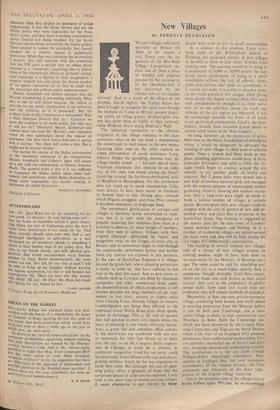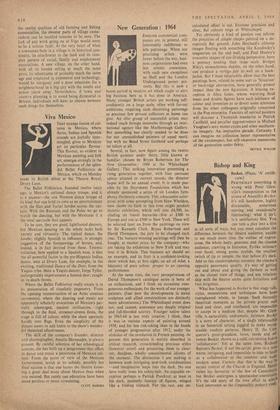New Villages
By TERENCE BENDIXSON The industrial revolution is the obvious originator of this village romance in the race- conscious, since on the one hand it depopulated the countryside to feed labour to the new manu- facturing cities and on the other created an urban environment of novel awfulness. Long- fellow's 'Under the spreading chestnut tree, the village smithy stands . . .' was just one of many Victorian utterances that rejoiced in an older way of life than was found among the hovels clustering around the far-from-chestnutted mills of Bradford or Birmingham. Yet this attribution does not stand up to much examination. Cities seem always to have been nearer in character to Sodom than to that shining place towards which Pilgrim struggled, and from Pliny onward it has been customary to disparage them.
The townsman's glorification of cottages and villages is therefore firmly entrenched in tradi- tion, but it is only with the emergence of popular Motoring that urbanites have been in a position to destroy, by sheer weight of numbers, what they seek to admire. Villages with their original character obliterated by 'semis' and bungalows exist on the fringes of every city in Britain, and as motorways begin to stab through the countryside, settlements farther and farther from city centres are exposed to this pressure. In the case of South-East England it is villages beyond the green belt, where planning permission is easier to come by, that have suffered in this way in the past few years. And as new towns or suburbs such as Croydon are filled by insurance companies and other commercial firms under the decentralisation of offices programme, it will become possible for large numbers of car com- muters to live, sixty, seventy or eighty miles from Charing Cross. Already villages in western Cambridgeshire are being thus affected as the improved Great North Road gives them speedy access to Stevenage. This is the sort of pattern that will develop in every city region where the basis of planning is new towns, inter-city motor- ways, a green belt and suburban office centres. If the motorways are combined with rail cars or monorails for their last fifteen or so miles into the city, as on the Congress Street express- way in Chicago, it could be a solution to commuter congestion. Land for car parks could be more easily found fifteen miles out, and above- ground railways would be far less expensive to build than tubes. But although this sort of plan- ning policy offers a glimmer of hope that the cancerous spread of cities can be stemmed, it will tend at the same time to swamp existing villages if some alternative is not offered to those
people who want to live in small communities.
As a solution to this problem, Leslie Gins- burg, head of the Birmingham School of Planning,. has proposed clusters of new villages to be built at three or four miles' distance from existing ones. The outcome would be to bring to a population of 8,000 to 10,000 people the sup- posed social satisfactions of living in a small community without the lack of schools, shops, clubs and services that tends to accompany it. I, would also make it possible to preserve many of our more attractive old villages, while giving more people the chance to enjoy them. Nor need such communities be thought of as rural varia- tion on an old suburban theme. As roads and railways in the city region arc improved, it will he increasingly possible for firms of all kinds to set up in small communities. Clark's, the shoe- makers, already have factories dotted about in several small towns in the West Country.
So long, however, as the protection of green belts rests on the flimsy foundations of ministerial whim, it would be dangerous to advocate the building of new villages in them even at selected points. Once a breach had been made at one place, planning applications would pour in from expectant developers and after a while the vil- lages would begin to coalesce around the old suburbs in yet another girdle of bricks and concrete.. But if green belts were turned into a new kind of lowland national park and managed with the express purpose of encouraging market gardening, forestry, farming and outdoor recrea- tion, then a long-term plan might be made to build a limited number of villages at suitable places. Beyond green belts new villages could be mingled with the sort of pattern of new and ex- panded towns and cities that is proposed in the South-East Study. One formula is suggested by the master plan for the new town of Cumber- nauld, between Glasgow and Stirling. In it a number of residential villages arc dotted around the main town and they will be built during the last stages of. Cumbernauld's construction.
The building of several isolated new villages and of a cluster of new villages around an existing nucleus ought to have been done as an experiment by the Ministry of Housing years ago. The same could be said for rebuilding part of an old city to a much higher density than is commonly thought desirable. Until these experi- ments are made and such factors as their social success, their cost to the community in profes- sional skills, farm land and travel time are evaluated, they will remain footballs of prejudice.
Meanwhile, at least one new private-enterprise village combining both houses and work places is awaiting permission from the Minister before it can be built near Cambridge, and a corn- muter village is about to start construction near Wrotham in Kent. Both the Cambridge one, . which has been promoted by the County Plan- ning Committee, and Vigo on the North Downs, which is the fruit of an ill-judged 1952 planning permission, have sophisticated modern plans. Cars are carefully channelled out of harm's and eye's way, footpaths abound and landscaping is lavish, The architecture is a far cry from Clough Wil Hams- Ellis's charmingly reactionary Port- me'rion in Cardigan Bay, but very conscious, nevertheless, of the stepped terraces, the little enclosures and alleyways of the more tight- packed of the English village traditions. This is the romantic view of the village coming to the surface again. Whether, by re-interpreting the spatial qualities of old farming and fishing communities, the sweeter parts of village cama- raderie can be recalled remains to be seen. The lack of any work going on at Vigo would seem to be a serious fault. At the very heart of what a townsman feels in a village is its historical con- tinuity, its attachment to the land and its com- plex pattern of social, family and employment associations. A new village, on the other hand, with all its houses selling at much the same price, its inhabitants of probably much the same age and employed in commerce and technology, would be inorganic and a poor substitute for a neighbourhood in a big city with the smells and noises taken away. Nevertheless, if town and country planning is to avoid being dictatorial in Britain. individuals will have to choose between such things for themselves.



































 Previous page
Previous page